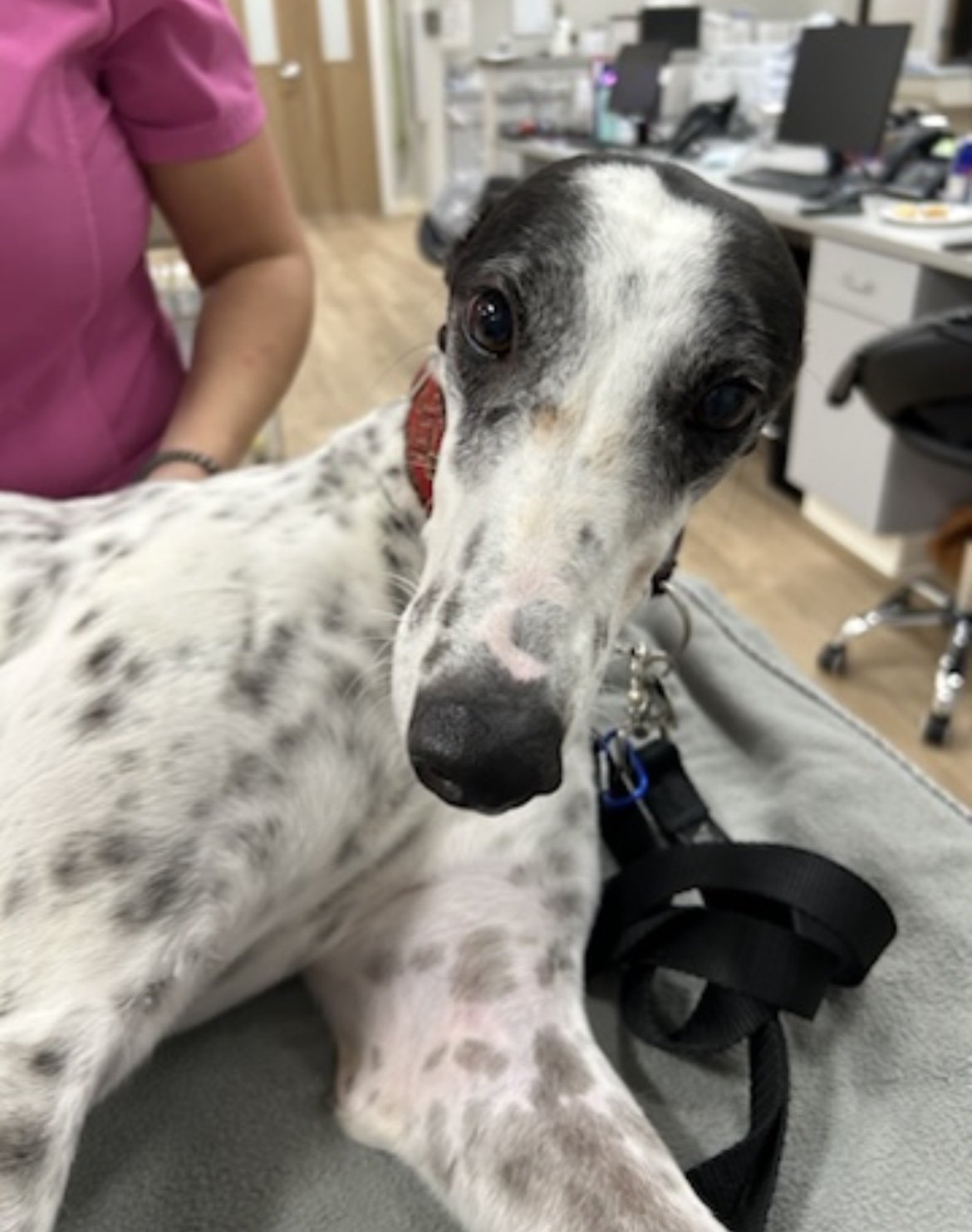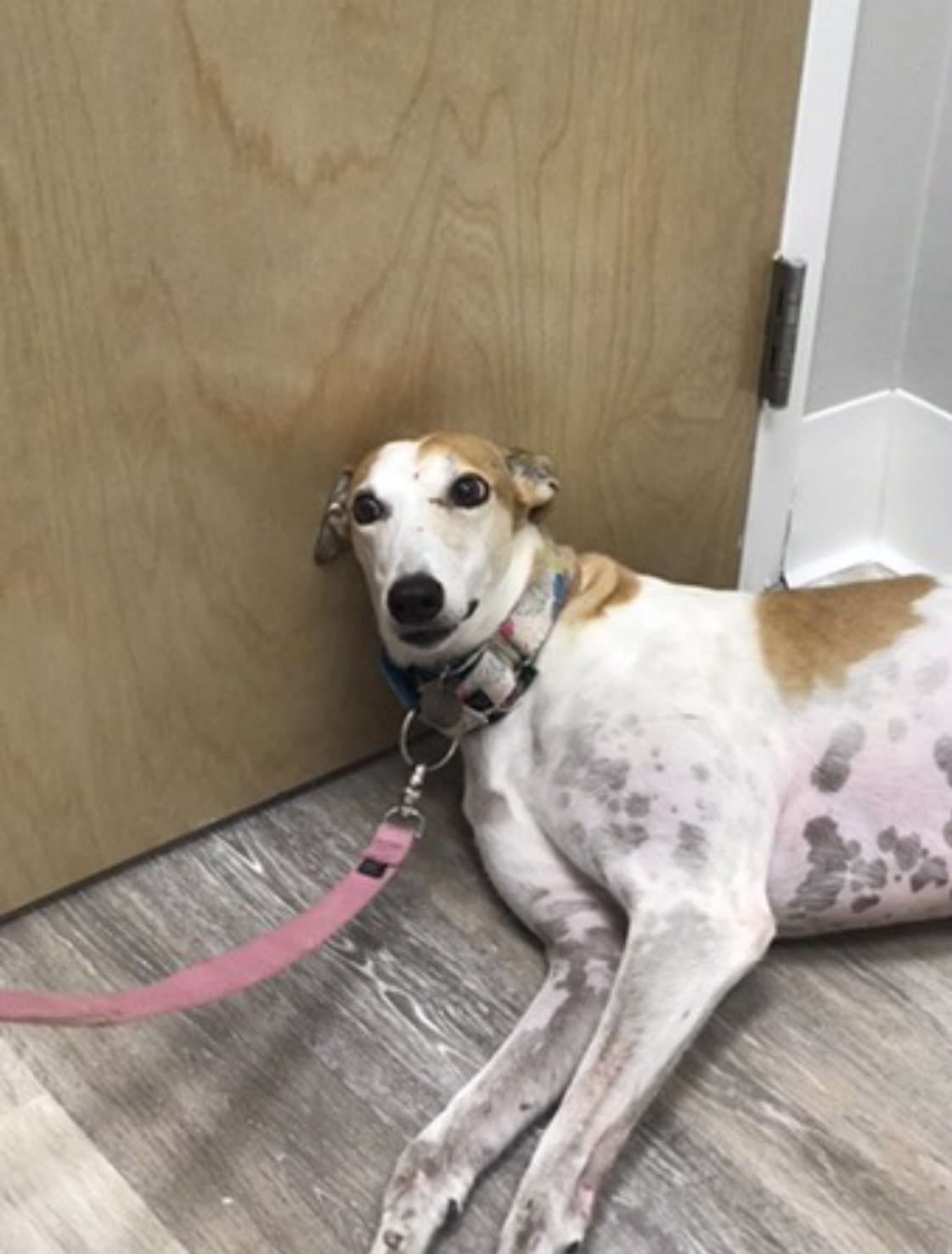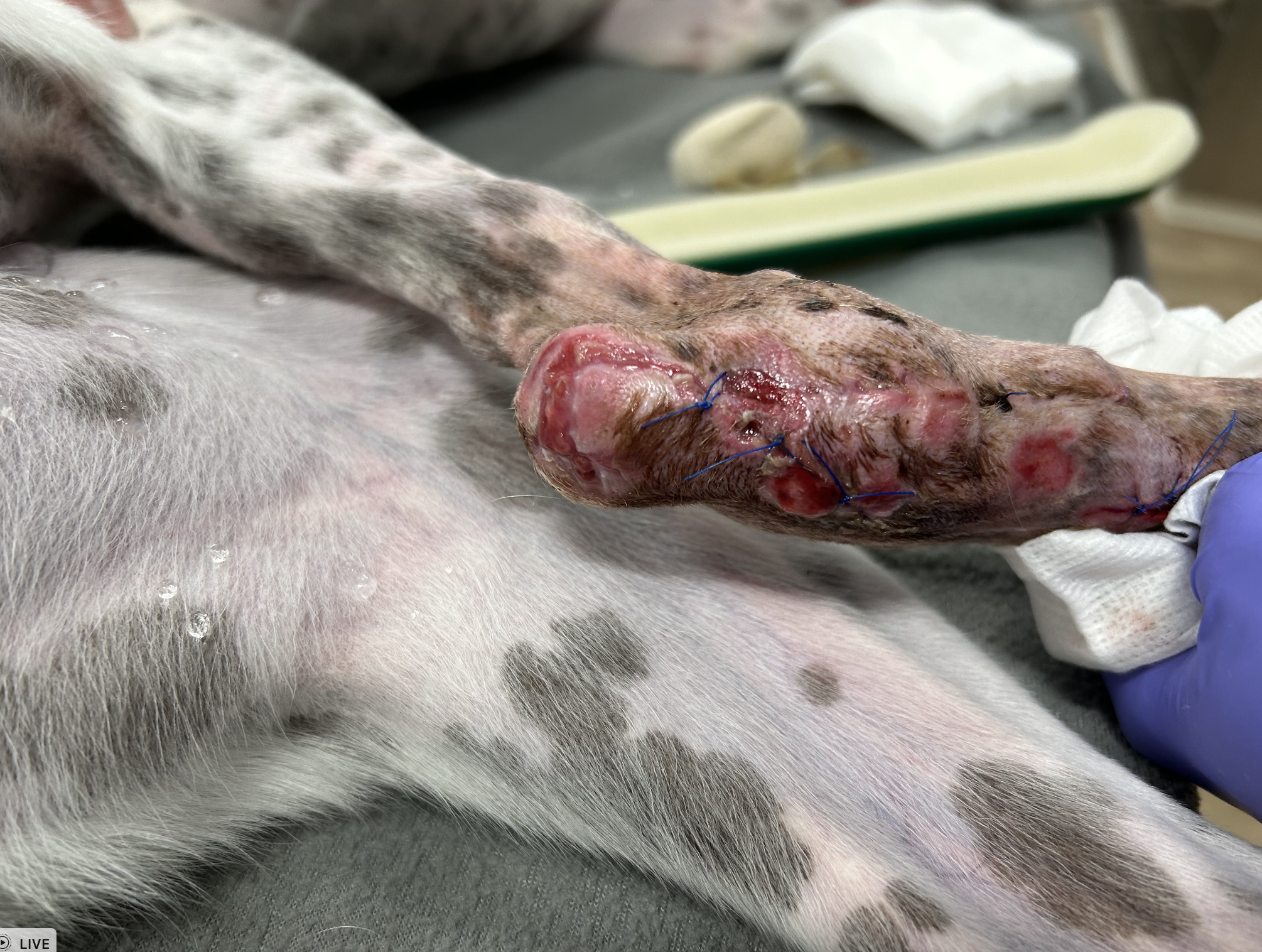Surgical Tips for Greyhound Owners and their Veterinarians.
Owning a Greyhound that has retired from racing is a wonderful adventure. These majestic and athletic beasts deserve a wonderful retirement after their time of racing (which they likely loved!). Some race for several seasons and some never race. In small animal surgial specialty practice, we often meet these dogs after track injuries, corns and osteosarcoma. Not unlike horses, Greyhounds can experience high impact injuries to their joints, especially the carpal (wrist) and tarsal (hock) joints. Typically, these injuries mean surgery and often retirement. Luckily surgery typically restores comfort and mobility, allowing for a life running again, when they want to. Regardless of the surgery type, we have tips to help your Greyhound recover as expediently as possible.
As a general resource to help with the “ins” and “outs” of Greyhounds, be sure to bookmark The Greyhound Health Initiative Website. It holds invaluable information on the Greyhound breed as well as any health updates that you should be aware of for your Greyhound.
Greyhound Reference Blood Values are Different than other Canine Breeds!
Prior to surgery, routine bloodwork is performed including a complete blood count (CBC) and Chemistry Panel (CHEM) including a urinalysis (UA). Greyhounds have many values that are normal for them but not for other breeds. Here is a link to those updated normals as stated by IDEXX.
This is a quick reference for Greyhound blood work reference ranges but use IDEXX link above for more extensive list of reference values.
Bleeding Tendencies:
One important thing to know about Greyhounds is that they have a tendency to bleed after surgery. Extensive bleeding/bruising after surgery can not only be painful but even life threatening. The discovery of the use of aminocaproic acid has been life-changing for racing Greyhounds. This medication prevents early breakdown of clots. In other words, clots are preserved to minimize delayed bleeding. Originally it was found to be beneficial for Greyhounds post operatively after amputations for osteosarcoma J Vet Emerg Crit Care 2012. This medication is typically given prior to surgery and 3 to 5 days after surgery. Extensive bleeding can even be seen in seemingly minor procedures such as tooth extractions. Doses range from 500mg for minor procedures to 1000mg for more extensive procedures or more severely affected dogs. For more information on aminocaproic acid dosing and mechanism of action click here (VetBloom 2016). Due to frequent shortages of aminocaproic acid, we have also learned that tranexamic acid works effectively for the same problem.
During racing, Greyhounds typically run counter clockwise. This means more stress on the outside hindlimb, leading to frequent injuries of the right hindlimb. Tarsal bone injuries, most commonly the central tarsal bone luxations can be seen. Additionally luxations of the joint spaces in the hock may also be seen. Typically, these injuries are best resolved with surgery. Surgical repair is then typically reinforced with external coaptation aka splints and bandages for several weeks.
The central tarsal bone gets compressed and forced out of the joint, often fracturing as it displaces. In surgery, the bone is replaced back to its original location, with lag screw fixation to the fourth tarsal bone.
The central tarsal bone is pictured to the left and colored lavender for clarity.
This is the cranial-plantar view (front to back)
This is a lateral view of the right hock in a greyhound that luxated its central tarsal bone. The joint space of the hock is notably collapsed as well.
Central Tarsal Bone Fracture
Here is another greyhound that fractured the central tarsal bone (slab fracture). Some cases can be managed with external coaptation (bandaging with splints) but most benefit earlier and more fully with surgery.
In some cases, external coaptation can be helpful before, after and in some cases instead of surgery. Because Greyhounds have such delicate skin and minimal fat on their extremities, they are extremely prone to bandage sores. Taking care to include enough padding when bandaging is key. The Therapaw company produces a bandage that works well for Greyhounds. It allows for soft padding and good support that can be adjusted with or without orthoplast inserts.
This tarsal support bandage is extremely helpful for SOFT padded support. The fleece option is suggested for Greyhounds due to their thin skin. A veterinarian prescription is required to order this item. Several measurements will be taken to ensure a good, custom fit. This bandage is a good fit for Greyhounds as it is not overly bulky with sufficient and variable support.
Bandaging 101 for Greyhounds
As discussed briefly above, when bandaged, Greyhounds require what might be seen as “excessive” padding. Greyhound bony protuberances are even more prone to decubital ulcers than your average dog. They do not have much fat on their extremities. This leads to rubs and sores with bandaging. Some sores can be serious if the bandaging technique is not improved. Increased padding in the right places will help. The use of stockinette “doughnuts” can be useful to pad around protuberances while also avoiding excessive direct pressure. These bandages can be placed in any region necessary e.g. over the digits at knuckles, over calcaneus, over anconeal process, carpal/tarsal lateral and medial protuberances.
Decubital Ulcer
This is a hock wound known as a decubital ulcer on a Greyhound as the result of bandaging. Although, it is impossible to eliminate bandage sores completely, this scenario is typically avoided with timely bandage changes and adequate cushioning in the bandage.
Below are several examples of bandage sores. Toes, boney proturberances, and pressure points are most easily affected. These regions are areas where stockinette doughnuts (see bandage material section below) would be beneficial. These allow for padding around the region without direct pressure on the wound. (left to right: toe, hock, toe, hock)
Stirrups are typically placed on either side of the limb to help secure the bandage. They can be placed medial/lateral orientation or cranial/palmar/plantar.
(photo credit: Clinician’s Brief)
Stirrups can be trimmed at bandage changes leaving the attachment on the limb to put the next stirrup over. For removal a pet safe adhesive removing solvent can be applied to gently remove the tape.
The first layer to be applied is the contact layer. Typically this is a non-adherent pad (Telfa) followed by “doughnuts” at perceived pressure points. Next layer is cast padding, lots and lots of cast padding. I typically use the 3” with greyhounds for the best fit. The idea is to have a cylindrical shape when done. After this is the stretch gauze layer to help secure the bandage with even, moderate pressure. Lastly is the Vetwrap layer which is the tertiary layer. It can be useful to reinforce the toes and top of bandage with elasticon. This also helps the toes to have traction. Allow digits 3 and 4’s toe nails to be exposed when possible. This will help detect swelling. If swelling is detected, the bandage should be immediately changed!!
Bandage protection for times when it will be exposed to the elements is crucial. The bandage can be protected with a freezer style ziplock bag, press n’ seal, temporarily. Once inside, this layer should be removed, so moisture will not be trapped in the bandage. Moisture is a leading cause of bandage sores, right up there with pressure sores. For longer term bandages or just to eliminate the hassle on short term bandages, a Medi-Paw bandage cover is quite useful. This is a heavy canvas sleeve that is secured with velcro. Any wet bandage should be quickly replaced!!
Bandage Covers:
The MediPaw company makes a reliable boot to cover and protect bandages from the elements. This is to be worn outside and removed once inside. There are multiple sizes available based on your Greyhound’s needs. After surgery it is not uncommon to have a bandage in place for 6 to 12 weeks. Use of a bandage cover will protect the bandage allowing for weekly bandage changes.
MediPaw
The MediPaw can be a lifesaver for your Greyhound. It will allow your bandage to better survive the elements. The Soft Bandage Boot is best for short term bandages (~2 weeks) and the Rugged Bandage is best for longer term and heavier bandages. All except the Healing Slim Boot must be removed after coming back inside. The other boots are waterproof but not breathable for more than 60 minute use.
One important thing to note is that, due to the very thin skin and lack of significant fat on the Greyhound extremities, implants can become exposed. Although initially alarming to the owner, this is not an emergency. In many cases, this will occur prior to full healing in which case, the site is monitored carefully for changes such as drainage, redness, heat or swelling. Typically a bandage is applied to protect the region during healing.
The patient pictured to the left had a fracture of the second metatarsal bone. The screw became exposed at ~12 months post operatively (bone had healed) and was removed on a non-emergent basis.
For additional educational resources, please click the link below for the Greyhound Health Initiative. They also accept donations to continue to help as many Greyhounds as possible.
More info coming on corns!…………




















